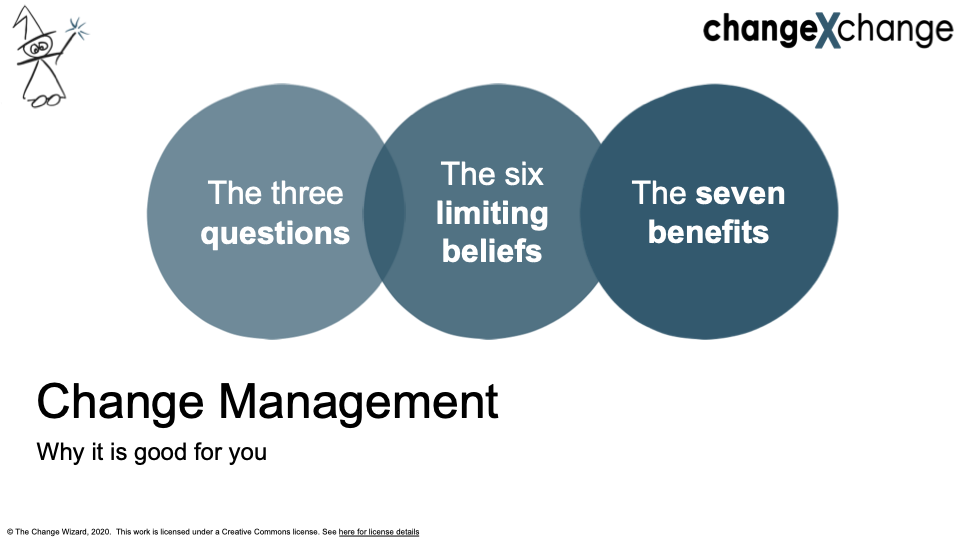The benefits of change management
If you are wondering why, or if change management is good for you, or is it worth the investment you are about to make, or if it is the first thing that gets cut from your budget, then this article is for you.
Developed with the generosity of our changeXchange think-tank, this article looks at assessing your change risk, the Six limiting beliefs and the Seven benefits. Powerful stuff.
This is the resource every change agent should have in their back pocket and every change leader should remind themselves of when they invest in change management.
Insight
We believe the root causes stem from ‘The decision maker does not believe in the value of good change management’.
Stakeholders do not understand the value (why), they have poor assumptions. and they do not understand the proposition expectations from prior experience. It is treated as an afterthought
Alternatively; we are pitching at the wrong person, or there is an overt choice not to invest.
We believe that asking questions is a powerful way to achieve self-awareness in our stakeholders.
This paper helps you identify the value at risk, the six limiting beliefs, and offers seven benefits of why change management is good for you.
With comprehensive questions to ask, this is a fantastic tool for any change agent, whether you are starting out or very experienced.
Before you start
Your role is to understand the perceptions and beliefs of those responsible, where there is a gap, you will have the information and understanding to design the interventions you need to shift the perceptions. This may take more than one intervention for success.
Who do I need to talk to?
Our first step is to identify who has the authority to invest the time, money or resources into managing the change.
Recognise that we may need to work through others as we do not have direct access to the person with the authority. Typically programme director/manager, leader or project sponsor
A ‘no’, is not a negative, or a never to be discussed, it is a data point and means ‘not now’
Use a role-map to map out who is in play; decision makers, advocates, influencers, targets of the change, their leaders, the project team. This will give you some insight.
Questions to ask :
Who determines how much is invested in changing the behaviour?
If you need to increase the budget, how would you do that?
If you ask permission to have the conversation, the other party is obliged to take part as they have given their permission. We highly recommend that the discussions are held as a 1:1 conversation to encourage greater authenticity.
Questions to ask :
You have a lot riding on this [change], to deliver your outcomes, I need to hear your opinions.
Are you OK if I put time in your diary?
I would like to explore your vision for this change, are you OK if I put time in your diary?
Establish value at risk
These questions are from the ‘Three Killer Questions’. Simple, easy to ask questions which raise self awareness of the value at risk.
Questions to ask
Does anyone need to think, act or believe something differently for [this change] to be successful?
How much of your benefits depend on people thinking, acting or doing something differently?
What are the consequences if people do not think, act or do things differently? or Will anyone get fired for not thinking, acting or doing things differently?
These quickly establishes the value at risk (project value * percentage dependent on people), and the likelihood (no consequences = low likelihood).
Explore the Past
Our experiences are the best indicators of how our beliefs have been shaped, understanding those beliefs gives you the sense of the gap, if any, that needs to be resolved.
At this point, the task is to explore, not to project your opinion.
Ask questions and listen carefully to the answers, drill deeper with ‘tell me more’, ‘what was it about…‘.
It is harder to go back and get clarification. This may be more than one conversation.
What success looks like
The scale of change needed
How important the change is
How much risk you are carrying
What good change management looks like
That projects typically fail to deliver
Questions to ask
Choose from these:
On success
What does success look like for you? [Drill into the tangible, visible outcomes]
What is your end goal? What excites you about [this change]? [The vision]
What does it look like long term? [Looking beyond the implementation]
Is this a commonly held view of [this change] and the rationale for it?
On Scale
What are the resources you will need to successfully embed [this change]?
What level of resource do you expect will be needed to change the behaviours?
What are the biggest shifts which need to be made?
On Importance
Why [this change]?, Why now?
What happens if you do not achieve [this change]?
If [this change] was to fail to gain traction, how would you feel?
What do you believe the ingredients are for success?
Who (or what) are the key drivers of [this change]?
What are you asking your teams to do?
On Risk Awareness
How big [or important] do you think [this change] is to your division/team/company?
What you believe your biggest risks of failure are? What concerns you about [this change]?How ready do you think we are for [this change]?
What more should you be doing to ensure success?How confident are you that your organisation can pull [this change] off? What might get in the way?
On Beliefs
What are the three things which you believe drive success of a project?
What advice would you give on how to successfully implement change around here, based on your experience?
What barriers to [this change] can you foresee? How are you planning to address them?
What conditions need to be met for [this change] to be successfully delivered?
On Past Experience
What was your most successful project? what made it a success?
What was your worst project? If you had your time again, what would you do differently?
Tell me about your most recent change experience’ How did you feel? What worked well, what would you do differently?
How satisfied have you been with the results delivered by previous projects?
Why Change Management?
Often misunderstood or added to a project out of obligation, the following prompts may help you explain the value of managing the behavioural change and implementation.
Remember; enquire first to understand their reluctance and pick accordingly.
Your Success
You will be associated with a success, rather than a failure.
I am here for your success, not your comfortYou will be perceived as a more effective leader, who successfully delivers transformational change.
Deliver your vision, bring it to life, make it real!
Do what few leaders before you have achieved.
Help you leave a legacy
In Control
We put you back in control, so that you can see whether you will be successful.
We give you an honest opinion and if necessary the brutal truth
No surprises, we remove the uncertainty of success or failure.
Give you the data and insights you need to make good decisions, choices and judgements
You can see the activities taking place and the impact that they are having
Positive Acceptance
Authentically address the barriers and concerns to [this change] so that they do not get in the way.
Listen to the end users, making sure the change is fit for purpose
Give people who are positive a loud voice to spread their excitement.
Generate positive acceptance from your user base, a low noise level throughout. Less distractions
Ensure that your teams [targets] continue to do, think and act differently in 12 months time.
We sustain [this change]
Build Muscle
Develop your leadership team to be transformational leaders Build the skills and resilience in your organisation so that they can respond positively to future change
Increase the capability of your leaders to lead change, which reduces cost of future implementations.
Build an adaptable organisation, one that changes easily
Realise Value
Ensure that the money you are investing in this will have a good return on investment (ROI)
Ensure that [this change] achieves its full objectives and value
Realise the full value of [this change] Remove the barriers that could get in the way of realising the value of [this change]
Save Money
Eliminate costs by getting it right and faster.
Save you money on things that have no value
Help you work smarter, not harder
Maintain Performance
Overcome resistance and maintain your performance outcomes.
Relatively seamless change from the perspective of the impacted teams to new ways of working
We would like to thank the changeXchange contributors for their help with this paper
To find out more about the activities of the changeXchange, and to join us for an upcoming brainstorming, see our website or follow us on LinkedIn
These insights were generated in Sept 2020.
Like what you see?
If you enjoyed this article and would like to have a regular weekly flow of insightful articles about change and leadership, sign up for our newsletter HERE. If you prefer daily insights, follow Irrational Change on LinkedIn.

